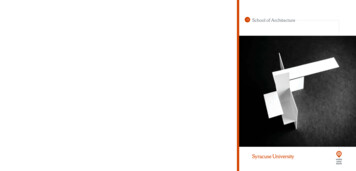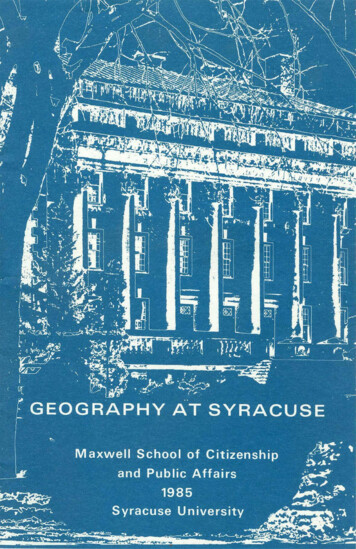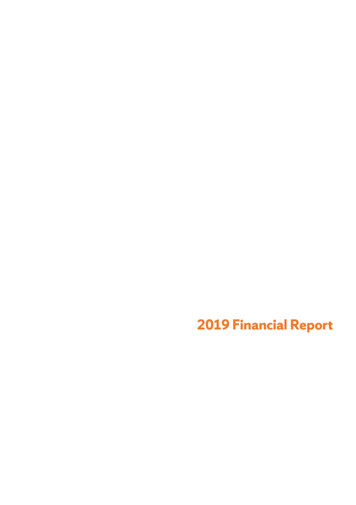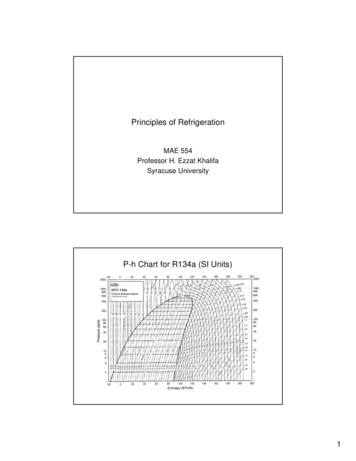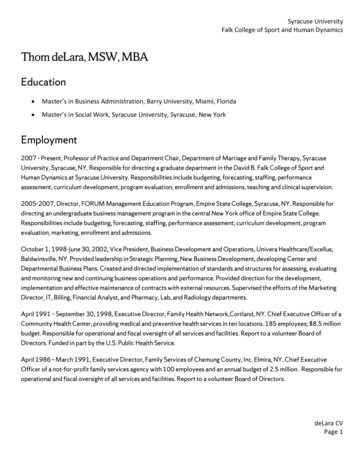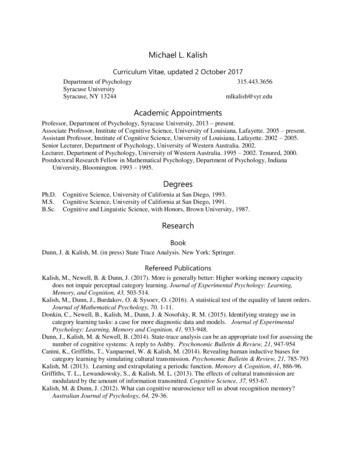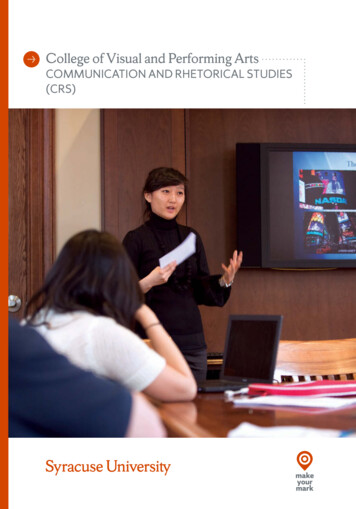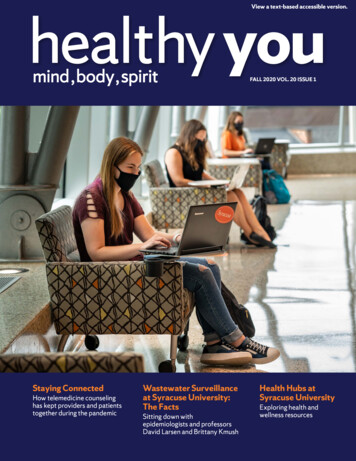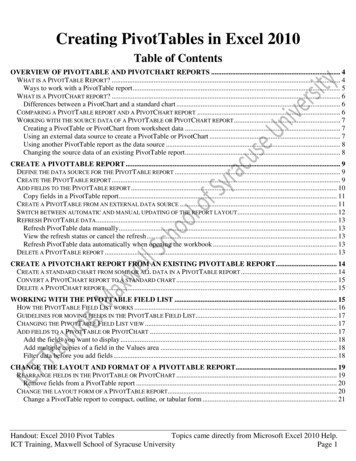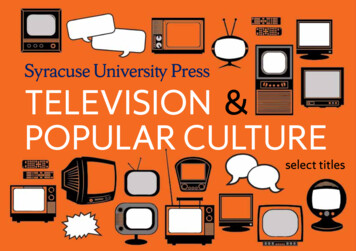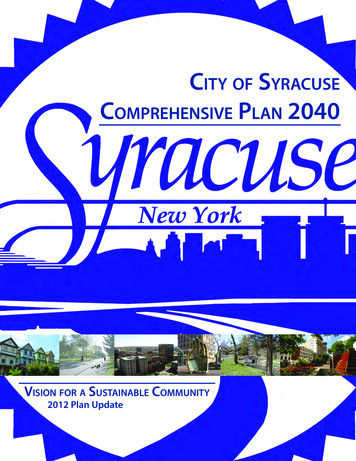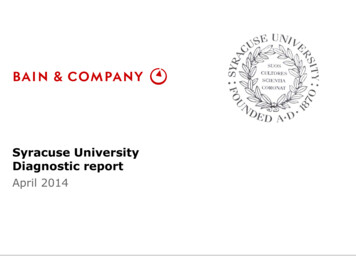
Transcription
Syracuse UniversityDiagnostic reportApril 2014
Agenda Report overview Project context Perspectives Next steps2
Purpose of this document This document contains findings from Bain & Company’s Diagnosticwork for Syracuse University in conjunction with the University’sSteering and Executive Committees (see slide 6 for members) The Steering Committee (composed of representatives from theUniversity leadership, deans, faculty, and administrative staff) andBain & Company present these findings after four months of detailedanalysis, review, and discussion; input was gathered from campusleaders, students, faculty, and staff via interviews, focus groups, andan online survey; data was acquired from SU and external sources The scope of the diagnostic consisted of elements from bothacademic and administrative functions of the University The findings underlying this report have been presented to theChancellor for his consideration3
Improvement programs typically involve three phases4 monthsDiagnostic Identifyopportunities toimproveefficiency andeffectivenessFocus ofthis reportDetailedSolution DesignImplementation Develop detailed Implement solutionssolutions to identifiedopportunities and plansfor implementing changeNot focus ofthis reportNot focus ofthis report4
Diagnostic overviewTHIS REPORT DOES THIS REPORT DOES NOT Assess the financial trends ofthe University Make recommendations ordecisions Compare Syracuse to peerinstitutions on key metrics Design or recommenddetailed solutions Identify areas of concern,inefficiency, orineffectiveness in Universityoperations Pre-judge future decisionmaking by campus leadersThe goal was to establish a fact base for theChancellor and Syracuse community to considerand offer Bain’s perspectives on opportunities5
Representatives from both faculty and theadministration provided us with input and guidanceEXECUTIVE COMMITTEESTEERING COMMITTEE Kal Alston, Senior VicePresident of Human CapitalDevelopment Executive committee in full, except for trustees Gwenn Judge, Director ofBudget and Planning Prof. Craig Dudczak, Budget Committee chair Louis Marcoccia, ExecutiveVice President and ChiefFinancial Officer Prof. Mary Lovely, Chair of the former Senate AdHoc Committee on Enrollment Chris Sedore, Associate ViceChancellor for AcademicOperations and CIO Eric F. Spina, Vice Chancellorand Provost Steve Barnes, Trustee H. John Riley, Trustee Prof. Shiu-Kai Chin, Faculty rep to the Board Prof. Sandra Lane, former Chair of the SenateAcademic Affairs Committee Dean Lorraine Branham (Newhouse) Dean Laura Steinberg (LC Smith College ofEngineering & Computer Science) Prof. Gail Bulman, Department Chair in Arts &Sciences (Languages, Literature, and Linguistics)DEANS Hannah Arterian, Law Douglas Biklen, Education Lorraine Branham,Newhouse Ann Clarke, Visual &Performing Arts Bea Gonzalez, ContinuingEducation Kenneth Kavajecz,Whitman George Langford, Arts &Sciences Elizabeth Liddy, iSchool Diane Murphy, Falk Michael Speaks,Architecture Kristen Jones-Kolod, Division of Student Affairs James Steinberg, Maxwell Jamie Cyr, Auxiliary Services Laura Steinberg,EngineeringMet 10 times for 2 hrs eachMet 6 times for 2-4 hrs eachOne-hour, one-on-oneinterviews followed bygroup discussions6
The diagnostic process included extensive interviews,data gathering, and a campus-wide surveyInterviews 110 interviewsacross campusincluding:- Faculty- Deans- Centraladministrators- Administrativestaff in theSchools andColleges- StudentsData gatheringand analysis Financial datafrom the Budgetoffice Course andenrollment datafrom OIRA and theRegistrar Course andfaculty data fromschools andcollegesBenchmarking Comparativedata from:- IPEDs- NACUBO- Chronicle of HigherEducation- Specialty firms- Peer institutions- Bain experience- Other sourcesSurvey Feedback from1200 Syracuseemployeesincluding 400faculty membersand 800 staff Function-specificdata from relevantUniversitydepartments7
Use of benchmarksDifferent peers were used for the three different types of metrics shown below– revenue, cost and academic metrics. Because every university is unique,benchmarks are never perfect comparisons, but they are helpful in identifyingareas for further review.AREAS OF INTERESTMetricsSAMPLE SCHOOLSPeer selection criteria Private universitiesRevenuemetrics Cost ofattendance,discount rate,fundraising, andresearch funding School ranking within US News rankingband Similar size of endowment Similar undergrad/grad mix Similar academic focusCostmetrics Instructional andadministrativecosts Private universities Similar total full-time undergraduateenrollment Similar cost of living Private, national doctoral universitiesAcademicmetrics Rankings,research, andcourse/programofferings Similar FT enrollment Similar academic focus Similar master’s vs. PhD mix Application overlap8
Agenda Report overview Project context Perspectives Next steps9
The diagnostic continues the University’s efforts tofurther enhance the institution The Senate Budget Committee recommended engaging anoutside firm for a review of the University’s structure, a review ofthe RCM system, and an effort to identify areas of administrativeduplication The Ad Hoc Committee on Enrollment surfaced importantUniversity-wide issues, including institutional capacity issuesrelated to enrollment growth, the need for improved data andanalytics, and the need for greater faculty/administrationcollaboration The Chancellor & the Vice Chancellor initiated a conversationlast spring about the changing higher education environment andthe University’s overall direction The Board of Trustees have continued to seek an enhancedunderstanding of the University’s challenges and opportunities There has been a leadership transition with the arrival ofChancellor Kent D. Syverud10
Syracuse is building on many strengths Programs of distinction that draw top students and faculty Many committed researchers doing groundbreaking workand excellent teachers drawing students to Syracuse Strong sense of school pride evident in focus groups andstaff survey Diversity, inclusion, and access ahead of many privatepeers Strong and well-known athletics program Historic campus that students indicate attracted them toSyracuse after a visit And much more 11
However, operating expenses are outgrowing revenuesTotal revenue: 3.6%Total expenses: 3.9%Note: Operating financials do not include participation and subvention; values for 2014 are budgetedSource: Syracuse financial reports12
Syracuse has grown enrollment at a higher rate thanmost peers – particularly undergraduate enrollmentNote: All enrollment CAGRs calculated based on IPEDS 12-month unduplicated headcount of total and undergraduate studentsSource: IPEDS 201113
Cost of attendance at Syracuse is low relative to peersNote: Tuition and fees from US News, room and board from IPEDSSource: IPEDS, US News and World Report14
Direct costs, central administration costs, and facilitiescosts have grown faster than operating revenueGROWTH RATE2010-2014BOperating revenue4.5%Direct school and college costs(excluding sponsored research)7.3%Central administrative costs6.1%Facilities costs6.9%Notes: Percents calculated off different basesSource: Syracuse financial data15
Many agree the Syracuse University must change inorder to be successfulQ: Syracuse University needs to change significantly to besuccessful in the next five yearsSource: Bain Syracuse University Diagnostic Survey, January 2014, N 1,22116
Agenda Report overview Project context Perspectives Next steps17
This diagnostic report provides a fact base andperspectives on sixteen opportunity areas1Set a vision for the UniversityAllocate resources tosupport vision23Achieve operationalexcellence in linewith visionGenerate resourcesto support visionBudgeting guidelines for use ofresources4Resource allocation across theUniversity5Tuition and discount rateDevelopment6Student retention7Marketing/Branding8910111213People (culture, capabilities,talent management)Organizational structureHuman resourcesSalary & fringeShared services and centers ofexcellenceInformation technologyand process nsourcing18
Strategic planningNeed for strategic planning(1 of 2)Allocate resources1PERSPECTIVESKEY FACTS AND DATA The University lacks an overarching strategicplan; some schools and colleges have embarkedon individual strategic plans In lieu of an overarching plan, strategic andresource allocation decisions have been ad hoc- Resources allocation for Schools and Colleges islargely based on 2006 funding levels- Portfolio of academic (e.g., degree programs) andnon-academic programs and portfolios have grownrapidly across the university- Syracuse exited from the AAU (given differenthistorical mix of science, engineering, and otherprograms vs. peers) & growth in Federal researchdollars has trailed peers A strategic plan, with clear vision,objectives, and explicit tradeoffs, wouldassist with decisions such as:-Allocation of resources (e.g., subsidy)Capital expendituresEnrollment managementOrganization structureHiringEmphasis in research and teachingGuidelines for unit leaders on enrollment,programs, and budgetsQ: Please answer the degree to which you agree with thefollowing statementsSources: Budget & Planning data, IPEDs, Bain SyracuseUniversity Diagnostic Employee Survey, January 2014, N 1,22119
Strategic planning:Strategic planning process(2 of 2)Allocate resources1KEY FACTS AND DATA The University lacks a regular processfor (1) setting and (2) evaluating progresstoward goals Syracuse could increase the degree towhich it systematically collects,reports, and incorporates intoplanning data such as:- Prospective student and parent demand,including needs and key selection criteria- Current student satisfaction levels- Competitive environment for faculty and stafftalent- The external market environment, includinginformation on the economy, grant-makingentities, and the activities of peer/competitorschools- Internal metrics, including teaching/researchmix, average class size, changes in researchactivity, and the mix of full-time and parttime instructorsPERSPECTIVES The strategic planning process shouldincorporate deep and up-to-date factbases on:- The external economic, regulatory, andcompetitive environment for higher education- Internal data on enrollment, faculty, staff,and financial trends The process should be “living” and setmeasureable goals in which progress isregularly evaluated in a transparentmanner The strategic planning process should alsoallow for regular evaluation andupdates as needed of the vision, goals,and prioritiesSource: Bain interviews20
Budgeting guidelinesAllocate resources2KEY FACTS AND DATA There is a high degree of frustration withperceived RCM disincentives and decision opacity The University’s current budgeting system, theResponsibility Management Center (RCM), asimplemented has fallen short:- Lack of understanding and transparency: There ismisunderstanding of RCM decisions, incentives, & impact- Limited accountability: Schools with higher reliance onbase subvention have seen level of subvention increase,not decrease; at the same time, schools have littlerecourse against increasing central administrativecharges and other budget impacts While there is limited evidence in course data thatRCM has decreased interdisciplinary activity, 80% of faculty surveyed believe RCM doesn’tencourage cross-school collaborationPRELIMINARYPERSPECTIVES RCM outcomes and perceptions could beimproved with potential changes,including:- Guideline and system design changes(e.g., 25/75 rule) that would generateadditional resources for priorities identified inthe strategic plan (e.g., research)- Increased clarity in RCM language, rules,and incentives- Increased transparency in subsidy decisionmaking, central cost allocation, and unitbudgets- Increased training to enhanced budgetingcapabilities in the units- The use of formula(s) or a standardizedprocess for cross-unit initiatives Increased two-way accountability(central and unit) for cost control couldencourage more responsible budgetingNote: Net contribution is net subsidy received/net tuition; net subsidy received is Participation (the tax rate) less all forms ofsubsidy (Subvention, Academic Plan Funds, etc.)Source: Bain Syracuse University Diagnostic Employee Survey, January 2014, N 1,221, Budget & Planning data21
Resource allocationAllocate resources3KEY FACTS AND DATA Syracuse offers more majors in more schools ofundergraduate instruction than peers While demand for credit hours and degrees hasshifted, direct costs grew faster than credithours delivered in 9 out of 11 schools Cross-school academic resource allocation decisionshave been based on pre-RCM funding levels Non-academic resource allocation has been ad hocas evidenced in widespread and varying investments(e.g., community engagement programs)“There is reluctance to tell people no and make hard tradeoffswith everyone in the room.”“We need to focus on investing where there is the biggest bangfor your buck.”PRELIMINARYPERSPECTIVES Funding for both academic and nonacademic programs should be alignedwith the strategic plan; differentialinvestment is needed in programsdeemed strategically important Improved enablers are needed; forexample:- Clear, transparent understanding of theUniversity’s academic and non-academicinvestments- Mechanism for measuring student demandfor classes- Process for regular measurement andevaluation of class and academic & nonacademic program offering- Clear priorities and university-wide themesfor deans and administrative departmentheads to invest in- Understanding of higher educationenvironment and areas of “market” growth“We can’t be everything to everyone. Where do we emphasize?”Source: Bain interviews, US News & World Report22
Tuition and discount rateGenerate resources4KEY FACTS AND DATA Gross cost of attendance is lowest among peers Undergraduate discount rate has grownsubstantially based on data reported to the SenateBudget Committee; however NACUBO data suggestsdiscount rate is in line with private peers Syracuse has a clear commitment to need-basedaid, providing a larger percentage of its students withneed-based aid than peers; at the same time,average merit-based discounts, as a % of totaltuition and fees, are lowest among peersPRELIMINARYPERSPECTIVES Enrollment management goals, cost ofattendance, total amount of financial aidprovided, mix of need and non-need based aid,distribution of discounts, and graduate discountrates should be aligned with the strategicplan, values, and overall financial capacityof the University 1/3rd of SU students receive more than a 60%discount while 1/3rd receive less than a 20% discountbased on a Senate Budget Committee report2013-14 undergraduate cost of attendanceNote: SU undergraduate tuition discount as a percentage of the University's total tuition revenues (RCM blended rate), asreported to the Senate Budget CommitteeSource: IPEDS, US News & World Report, Senate Budget Committee, University websites, Budget & Planning data23
DevelopmentGenerate resources5KEY FACTS AND DATA Private support consistently trails peers by 20M The efficiency and effectiveness of developmentprocesses were rated in the bottom third of allprocesses in the staff survey Development overall is understaffed relative to thirdparty benchmarks Development data systems are not consistentlyused and do not provide true customer-relationshipmanagement (CRM) capabilities Development activities must be better coordinated;high-value donors can receive multiple duplicativesolicitationsPERSPECTIVES Fundraising objectives and focusshould be aligned to strategic plan;potential steps might include:- Additional frontline gift officers focused onareas and geographies of greatestopportunity- Standardized use of a development trackingsystem across units with robust relationshipmanagement capabilities to ensurecoordination- Measurement of performance and greaterincentives for both central and distributed giftofficers- An appropriate mix of centralized anddistributed development officers- Faculty involvement in identifying highpotential students for early engagement- An improved understanding of the potentialfor support from international alumniNote: Peer average consists of Boston University, Brandeis, Carnegie Mellon, GWU, Georgetown, SMU, Tufts, Tulane, U. of Miami,Wake Forest, YeshivaSource: IPEDs, Eduventures24
Student retentionGenerate resources6KEY FACTS AND DATA Syracuse freshman retention overall is strongand in line with peers (92% vs. 94% peeraverage) However, international students and traditionallyunderrepresented minorities have loweraverage cumulative 4-year retention rates Retention early warning systemimplementation is in progress; additionaltraining is planned but use of the system couldbe expanded The Syracuse student body today is differentthan it was ten years ago:- The nature of college-going students is different interms of need for financial aid, academic interests,extra-curricular focus, and need for student services- The mix of Syracuse students has also shiftedPERSPECTIVES Coordinated investment in retention hasboth financial and non-financial benefits forthe University Key enablers could help further supportretention efforts, including:- An improved and comprehensiveunderstanding of the drivers of studentattrition given changes in the make up ofSyracuse’s student body- Improved coordination across units oninternational and minority student retention,particular with regards to housing- Training on enhanced and more widely usedretention early warning systems- Additional support for faculty to adapt theirinstructional methods for the changing studentbody- Regular, ongoing evaluation of changingstudent needsNote: Peer average includes American University, Boston College, Boston University, George Washington University, GeorgetownUniversity, Northeastern, Northwestern, Southern Methodist, Tulane, Rochester, and VanderbiltSource: Syracuse enrollment data, Bain interviews25
Marketing/brandingGenerate resources7KEY FACTS AND DATA Branding and style lacks consistency; theSyracuse name does not appear in many schoollogos or school websites, and websitesthemselves vary greatly in terms of style andorganization Interviews suggest communications efforts canbe duplicative or uncoordinated across units Syracuse does not consistently measurestakeholder (e.g., prospective students, parents,donors, grant-making entities, news media)perceptions or interactions A higher percentage (58%) of Syracusemarketing, communication, and public affairsemployees are decentralized compared topeersExample logos:PERSPECTIVES University-wide marketing, branding,and communications should be alignedwith the strategic plan and ensurecohesive messaging for stakeholdergroups:-Prospective studentsCurrent studentsDonors and alumniGeneral publicGovernment and grant-making entities A “center of excellence” approach maybest leverage central capabilities butpreserve unit ownershipSource: University websites, Bain interviews26
People (culture, capabilities, and talent)Operational excellence8KEY FACTS AND DATA The top recommendation of Syracuse employees inBain’s Diagnostic Employee Survey was increasedtransparency, communication, and collaboration Interviews suggest there are gaps in required skillsand capabilities to perform jobs in certain jobfunctions/areas Survey takers point to lack of professionaldevelopment and training opportunities Survey takers also believe greater recognition ofstrong performance and/or fairness in evaluationsis neededPERSPECTIVES Increased transparency in decisionmaking and consistency ofcommunication about major decisionswould help enhance culture of t
Sources: Budget & Planning data, IPEDs, Bain Syracuse University Diagnostic Employee Survey, January 2014, N 1,221 1 . 20 Strategic planning: (2 of 2) Strategic planning process Allocate resources KEY FACTS AND DATA PERSPECTIVES The strategic plannin
